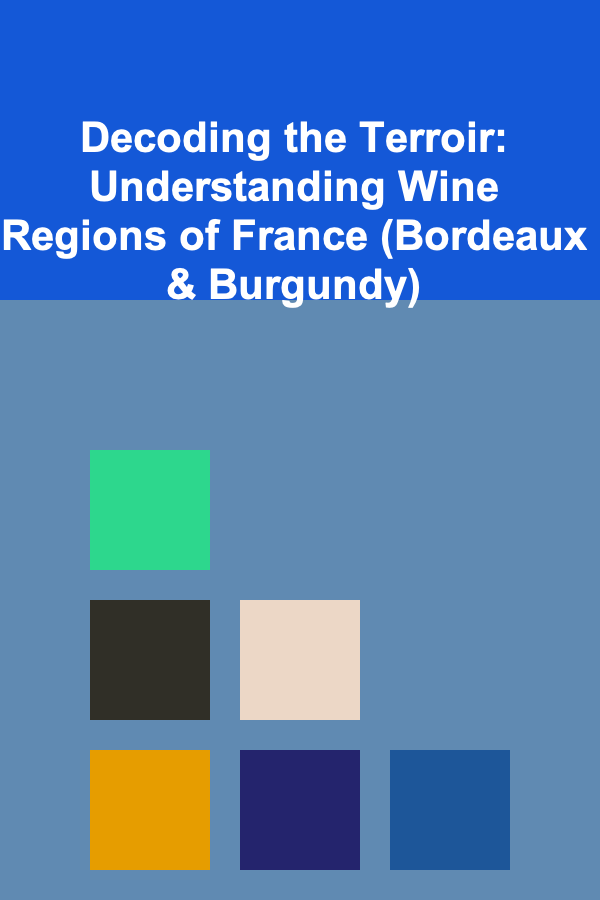
Decoding the Terroir: Understanding Wine Regions of France (Bordeaux & Burgundy)
ebook include PDF & Audio bundle (Micro Guide)
$12.99$10.99
Limited Time Offer! Order within the next:

France, the birthplace of some of the world's most revered wines, holds a special place in the hearts of wine enthusiasts. Its diverse terroirs, centuries of tradition, and meticulous winemaking practices contribute to the unparalleled quality and complexity of its wines. Among France's many esteemed regions, Bordeaux and Burgundy stand out as titans, each with its own unique character, history, and contribution to the world of wine. Understanding these two regions is not just about learning grape varieties or appellation names; it's about grasping the intricate interplay of geography, climate, soil, and human influence -- the essence of terroir.
The Concept of Terroir: More Than Just Dirt
Before delving into the specific characteristics of Bordeaux and Burgundy, it's crucial to understand the concept of terroir. Often translated as "a sense of place," terroir encompasses all the environmental factors that influence a wine's characteristics. It's a holistic concept that includes:
- Climate: The average temperature, rainfall, sunshine hours, and diurnal range (difference between day and night temperatures) significantly impact grape ripening, acidity, and flavor development.
- Soil: The soil composition (e.g., clay, limestone, gravel) influences drainage, nutrient availability, and vine vigor, which in turn affects grape quality.
- Topography: The slope and aspect (direction the slope faces) affect sunlight exposure and drainage, impacting grape ripening and temperature.
- Geology: The underlying bedrock and geological history shape the soil composition and influence mineral uptake by the vines.
- Human Influence: Winemaking traditions, vine training methods, and cellar practices all contribute to the final expression of the wine.
- Biome: The combination of all living things in the region. This influences soil composition and health, as well as the overall climate.
Terroir is not a static concept; it's a dynamic interaction of all these elements, constantly evolving and influencing the character of the wine. It's what makes a Bordeaux wine distinct from a Burgundy, even if both are made from Cabernet Sauvignon or Pinot Noir (though of course, Cabernet Sauvignon is rarely, if ever, used in Burgundy). The nuances of terroir are what connoisseurs seek to decipher, making each bottle a unique expression of its origin.
Bordeaux: The Land of Cabernet Sauvignon and Merlot
Bordeaux, located in southwestern France, is renowned for its powerful and age-worthy red wines, primarily made from Cabernet Sauvignon, Merlot, and Cabernet Franc. The region's maritime climate, influenced by the Gironde estuary and the Atlantic Ocean, contributes to moderate temperatures and consistent rainfall. The diverse soil types, ranging from gravelly to clay-rich, further add to the complexity of Bordeaux wines.
Geographical Overview
Bordeaux is divided into two main banks: the Left Bank and the Right Bank, separated by the Gironde estuary. These banks are further subdivided into numerous appellations, each with its own unique characteristics.
- Left Bank: Dominated by Cabernet Sauvignon, the Left Bank is characterized by gravelly soils that provide excellent drainage. This leads to wines with higher tannins, structure, and aging potential. Major appellations include:
- Médoc: Home to prestigious appellations like Pauillac, Margaux, Saint-Julien, and Saint-Estèphe, known for their powerful and complex Cabernet Sauvignon-based wines. These wines often exhibit notes of blackcurrant, cedar, and tobacco.
- Haut-Médoc: Encompasses a wider area south of the Médoc, producing wines that are typically more approachable in their youth.
- Graves: South of the Médoc, known for both red and dry white wines. The red wines are typically Cabernet Sauvignon dominant, with a blend of Merlot and Cabernet Franc.
- Right Bank: Dominated by Merlot and Cabernet Franc, the Right Bank features clay-rich soils that retain moisture. This results in wines that are softer, rounder, and more approachable at a younger age. Major appellations include:
- Pomerol: Home to the legendary Château Pétrus, Pomerol is known for its opulent and intensely flavored Merlot-based wines.
- Saint-Émilion: Renowned for its elegant and complex wines, typically a blend of Merlot and Cabernet Franc. It also has a hierarchical classification system within the appellation, recognizing exceptional estates.
- Entre-Deux-Mers: Located between the Garonne and Dordogne rivers, this region primarily produces dry white wines made from Sauvignon Blanc, Sémillon, and Muscadelle. While not as prestigious as the Left and Right Banks, it offers excellent value.
- Sauternes & Barsac: Located in the Graves district, these appellations are famous for their sweet, botrytized wines made from Sémillon, Sauvignon Blanc, and Muscadelle. These wines are rich, complex, and age-worthy.
Key Grape Varieties
- Cabernet Sauvignon: The dominant grape of the Left Bank, providing structure, tannins, and black fruit flavors.
- Merlot: The dominant grape of the Right Bank, contributing softness, roundness, and red fruit flavors.
- Cabernet Franc: Adds aromatic complexity, herbaceous notes, and structure to Bordeaux blends. Plays a key role in many Saint-Émilion wines.
- Petit Verdot: A small percentage often added to Bordeaux blends for color, tannins, and spice.
- Sémillon: A key grape in sweet wines like Sauternes and Barsac, providing richness and honeyed flavors. Also used in dry white blends for body and texture.
- Sauvignon Blanc: Adds acidity and citrusy aromas to dry white Bordeaux blends.
Understanding Bordeaux Wine Labels
Decoding a Bordeaux wine label can seem daunting, but understanding the key elements can make the process much easier.
- Château: Indicates a wine produced from a single estate. However, "Château" does not guarantee quality, so look for other indicators.
- Appellation: The geographical origin of the wine, indicating the region where the grapes were grown. For example, "Pauillac" or "Saint-Émilion." Higher quality wines will usually display a more specific appellation.
- Vintage: The year the grapes were harvested. Vintage variation is significant in Bordeaux, with some years producing exceptional wines and others being more challenging. Consult vintage charts for information on the quality of specific years.
- Cru Classé: Indicates a classification based on the 1855 classification of Médoc and Sauternes wines. This classification ranks châteaux based on their historical quality and prices, but it's not a guarantee of current quality. Saint-Émilion also has its own classification system, which is periodically updated.
- Mis en Bouteille au Château (or au Domaine): Indicates that the wine was bottled at the estate where the grapes were grown. This is generally considered a sign of higher quality.
Tasting Notes and Characteristics
Bordeaux wines are known for their complex aromas and flavors, which develop over time. Here are some common tasting notes:
- Young Bordeaux (3-5 years): Red and black fruit (blackcurrant, plum), cedar, tobacco, vanilla (from oak aging), firm tannins.
- Mature Bordeaux (10+ years): Evolved aromas of leather, earth, truffle, spice, softer tannins, more integrated flavors.
The characteristics of a Bordeaux wine will vary depending on the appellation and grape composition. Left Bank wines tend to be more structured and tannic, while Right Bank wines are generally softer and more approachable. High-quality Bordeaux wines are known for their ability to age gracefully for decades.
Burgundy: The Home of Pinot Noir and Chardonnay
Burgundy, located in eastern France, is celebrated for its elegant and nuanced red and white wines, primarily made from Pinot Noir and Chardonnay, respectively. The region's continental climate, characterized by cold winters and warm summers, contributes to significant vintage variation. The mosaic of soil types, ranging from limestone to clay, further adds to the complexity and diversity of Burgundy wines.
Geographical Overview
Burgundy is a long, narrow region divided into five main sub-regions, each with its own distinct characteristics.
- Chablis: Located in the northernmost part of Burgundy, Chablis is known for its crisp and mineral-driven Chardonnay wines. The Kimmeridgian limestone soils contribute to the wines' distinctive minerality and acidity.
- Côte de Nuits: Home to some of the most prestigious Pinot Noir vineyards in the world, the Côte de Nuits produces powerful and complex red wines with great aging potential. Key appellations include Gevrey-Chambertin, Morey-Saint-Denis, Chambolle-Musigny, and Vosne-Romanée.
- Côte de Beaune: Known for both red and white wines, the Côte de Beaune produces elegant and balanced Pinot Noir wines, as well as rich and complex Chardonnay wines. Key appellations include Pommard, Volnay, Beaune (red), Meursault, Puligny-Montrachet, and Chassagne-Montrachet (white).
- Côte Chalonnaise: Offers more affordable Burgundy wines, with a focus on Pinot Noir and Chardonnay. Key appellations include Rully, Mercurey, and Givry.
- Mâconnais: Located in the southernmost part of Burgundy, the Mâconnais produces primarily Chardonnay wines that are typically lighter and fruitier than those from the Côte de Beaune. Key appellations include Pouilly-Fuissé and Saint-Véran.
Key Grape Varieties
- Pinot Noir: The dominant red grape of Burgundy, known for its delicate flavors, silky tannins, and complex aromas. It's highly sensitive to terroir, expressing the nuances of each vineyard.
- Chardonnay: The dominant white grape of Burgundy, capable of producing a wide range of styles, from crisp and mineral-driven (Chablis) to rich and buttery (Côte de Beaune).
- Aligoté: A white grape variety that produces crisp, acidic wines, often used in the Bourgogne Aligoté appellation.
- Gamay: Primarily grown in Beaujolais, which, while technically part of the Burgundy region, is often treated separately due to its unique style of wine. Gamay produces light-bodied, fruity red wines.
Understanding Burgundy Wine Labels
Burgundy wine labels can be even more complex than those from Bordeaux, due to the region's fragmented ownership and complex classification system.
- Domaine: Similar to "Château" in Bordeaux, indicates a wine produced from a single estate. Increasingly common.
- Négociant: A wine merchant who buys grapes or finished wine and bottles it under their own label. A common practice in Burgundy.
- Appellation: The geographical origin of the wine, indicating the region where the grapes were grown. Burgundy has a hierarchical appellation system:
- Regional Appellations: Cover the entire Burgundy region (e.g., Bourgogne Rouge, Bourgogne Blanc).
- Village Appellations: Cover a specific village (e.g., Gevrey-Chambertin, Meursault).
- Premier Cru (1er Cru): Indicates a specific vineyard within a village that is considered to be of higher quality. The vineyard name will be listed on the label along with "Premier Cru."
- Grand Cru: The highest level of appellation, representing the best vineyards in Burgundy. Grand Cru vineyards are independently classified and do not belong to a village. The vineyard name will be listed on the label, and the appellation will simply state "Grand Cru."
- Vintage: The year the grapes were harvested. Vintage variation is even more significant in Burgundy than in Bordeaux, with some years producing exceptional wines and others being more challenging.
- Mis en Bouteille au Domaine (or à la Propriété): Indicates that the wine was bottled at the estate where the grapes were grown.
Tasting Notes and Characteristics
Burgundy wines are known for their elegance, finesse, and complex aromas, which can evolve dramatically with age. Here are some common tasting notes:
- Young Pinot Noir (3-5 years): Red fruit (cherry, raspberry), floral notes (rose, violet), earthy undertones, silky tannins, high acidity.
- Mature Pinot Noir (10+ years): Evolved aromas of forest floor, truffle, game, spice, softer tannins, more integrated flavors.
- Young Chardonnay (3-5 years): Citrus fruit (lemon, grapefruit), green apple, mineral notes (flint, chalk), high acidity.
- Mature Chardonnay (5+ years): Evolved aromas of hazelnut, butterscotch, honey, richer texture, more integrated flavors. The expression can vary drastically from the steely, mineral Chablis to the richer, oak-influenced Meursault.
The characteristics of a Burgundy wine will vary greatly depending on the appellation and producer. Pinot Noir wines can range from light and fruity to powerful and complex, while Chardonnay wines can range from crisp and mineral-driven to rich and buttery. High-quality Burgundy wines are highly sought after for their elegance, complexity, and ability to age.
Key Differences and Similarities: Bordeaux vs. Burgundy
While both Bordeaux and Burgundy produce exceptional wines, they differ significantly in their style, grape varieties, and approach to winemaking.
Key Differences:
- Grape Varieties: Bordeaux is primarily a blend of Cabernet Sauvignon, Merlot, and Cabernet Franc, while Burgundy focuses on single-varietal wines made from Pinot Noir (red) and Chardonnay (white).
- Climate: Bordeaux has a maritime climate with moderate temperatures and consistent rainfall, while Burgundy has a continental climate with greater vintage variation.
- Soil: Bordeaux has diverse soil types ranging from gravelly to clay-rich, while Burgundy is characterized by a mosaic of limestone and clay soils.
- Wine Style: Bordeaux wines tend to be more structured and tannic, while Burgundy wines are generally more elegant and nuanced.
- Appellation System: Bordeaux has a more straightforward appellation system, while Burgundy's is more complex, with a hierarchical classification system based on vineyard quality.
- Winemaking Philosophy: Bordeaux winemaking often involves blending multiple grape varieties, while Burgundy winemaking emphasizes the expression of single vineyards through minimal intervention.
- Price: In general, the most prestigious Bordeaux wines are more expensive than their Burgundy counterparts, although top-tier Burgundy Grand Crus can command extremely high prices. This is due to a combination of factors, including production volume, demand, and the perceived scarcity of top Burgundy vineyards.
Similarities:
- Emphasis on Terroir: Both regions deeply value the concept of terroir and believe that it is the primary driver of wine quality.
- Long History of Winemaking: Both Bordeaux and Burgundy have a long and rich history of winemaking, with traditions passed down through generations.
- Focus on Quality: Both regions are committed to producing high-quality wines that reflect the unique characteristics of their respective terroirs.
- Aging Potential: Both Bordeaux and Burgundy wines, particularly those from the top appellations, have the potential to age gracefully for many years, developing complex aromas and flavors over time.
Beyond the Basics: Further Exploration
This overview provides a foundation for understanding the wine regions of Bordeaux and Burgundy. However, there is much more to explore. Consider the following:
- Vintage Variation: Research vintage charts and learn how different weather conditions affect the quality and style of wines from each region.
- Producer Influence: Explore the styles of different producers within each appellation to discover your personal preferences.
- Food Pairing: Experiment with pairing Bordeaux and Burgundy wines with different foods to enhance your dining experience.
- Visit the Regions: If possible, visit Bordeaux and Burgundy to experience the terroir firsthand and meet the winemakers.
- Attend Wine Tastings and Seminars: Expand your knowledge by attending wine tastings and seminars focused on Bordeaux and Burgundy.
- Read Books and Articles: Continue to learn about the history, geography, and winemaking practices of these fascinating regions.
Understanding Bordeaux and Burgundy wines is a lifelong journey. By embracing the concept of terroir and continually expanding your knowledge, you can unlock the secrets of these legendary wine regions and appreciate the unique beauty and complexity of their wines.

Best Organization Tools for Budget Travel
Read More
Effective Strategies for IT Support Specialists: Mastering Technical Support and Customer Service
Read More
How to Organize Your Family's Digital Devices
Read More
How to Set Up a Craft Area That Stays Organized
Read More
How to Store Your Kids' Toys Without Taking Over the House
Read More
How to Create a Child-Safe Interior
Read MoreOther Products

Best Organization Tools for Budget Travel
Read More
Effective Strategies for IT Support Specialists: Mastering Technical Support and Customer Service
Read More
How to Organize Your Family's Digital Devices
Read More
How to Set Up a Craft Area That Stays Organized
Read More
How to Store Your Kids' Toys Without Taking Over the House
Read More